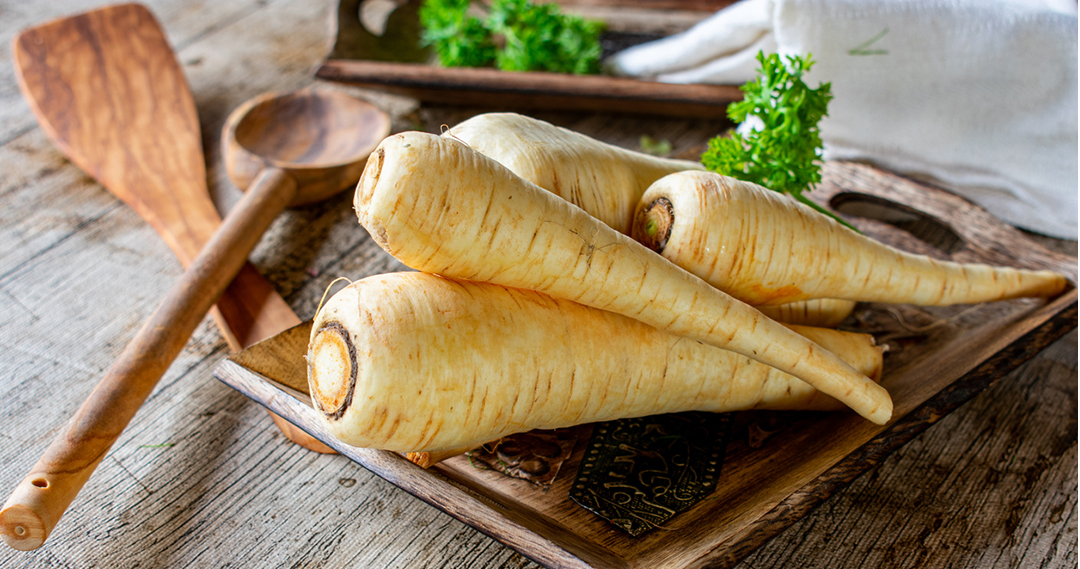Parsnips

Health Power
Benefits are similar to potatoes. The main difference: parsnips have more fiber and folate but less vitamin C per weight. (Still a great source, with half the RDA of C in one parsnip.) With more dietary fiber, parsnips better support digestion. They help everything flow smoothly, get rid of excess cholesterol and regulate blood sugar. Folate is known to lower homocysteine in the blood, preventing plaque buildup that harms blood vessel structure. Pregnant women need folate to promote healthy fetal nerve development. Also a good source of vitamin K, which helps develop a dense bone matrix. Parsnips have some B vitamins that help boost fat, protein and carbohydrate metabolism to provide energy.
Vitamin and Mineral Content
Vitamins – Vitamins – C, K, B9 (Folate), E, B1 (Thiamin), B5 (Pantothenic Acid) and B6 (Pyridoxine)
Minerals – Manganese, Potassium, Magnesium, Phosphorus and Copper
Disease Prevention
Vitamin B6 and folate help reduce homocysteine levels, helping to prevent heart attacks and strokes. Vitamin B6 also fights cancer by attaching signals to molecules that lead to turning on tumor suppressive genes. This type of signaling, methylation, also signals to destroy toxic, potentially carcinogenic, chemicals. The fiber in parsnips helps prevent colon cancer and the onset of diabetes. The fiber may also reduce the risk or onset of heart disease, stroke and heart attack.
How to Grow
Parsnips grow in many different soil types. For best results, choose a sunny, sheltered site with deep soil. The pH should be around 6.5; add lime to raise, if needed. In cooler climates, sow seeds as soon as the soil starts to warm and is workable (early to mid-spring). In warmer climates that do not freeze, sow seeds in the fall. Loosen the soil to 2 feet down. Remove any large solid chunks like rocks. Amend the soil with a few inches of compost or equivalent planting mix. Soak seeds in warm water for several hours to promote germination. Create shallow drills 1 foot apart and sow seeds 1 inch deep 6 inches apart. Do not let soil dry out while waiting for germination. Mulch lightly around the base of the plants once they are a few inches tall. Hoe to keep rows weed free, making sure not to damage roots. Water deeply once a week to supply the whole root and avoid rot from sitting water. If soil dries out, water again to keep it moist and prevent cracking of roots. Parsnips take 3-4 months to mature. They are usually ready in late fall to early winter. Use a garden fork to loosen soil around plants before pulling. Lift roots after first frost. Enjoy or store for winter use.
Insect Control
Common pests for parsnips are carrot root flies. They are also susceptible to canker. The larva of the female fly burrows into the root, leaving tunnels and brown marks. To prevent females from laying eggs at root base, put a plastic barrier around parsnips, carrots or celery supported by posts. This keeps females from approaching the base of the plant. Parsnips have canker if they show red-brown marks on the top of the roots, which leads to rot. To prevent, do not over water or over fertilize. Use balanced practices to develop a healthy plant. Also, look for resistant cultivars.
Tips
To store parsnips, gently place undamaged ones in a container and fill in gaps with moist peat, sawdust or sand. Put the container in a cool, frost-free area.





